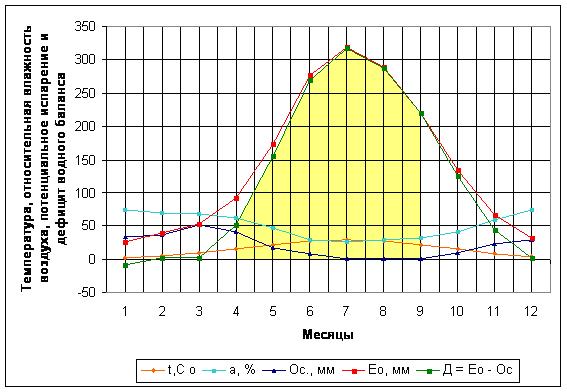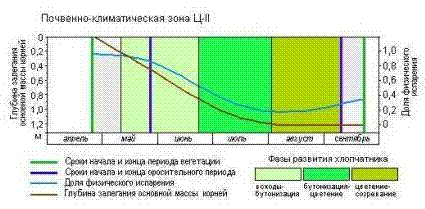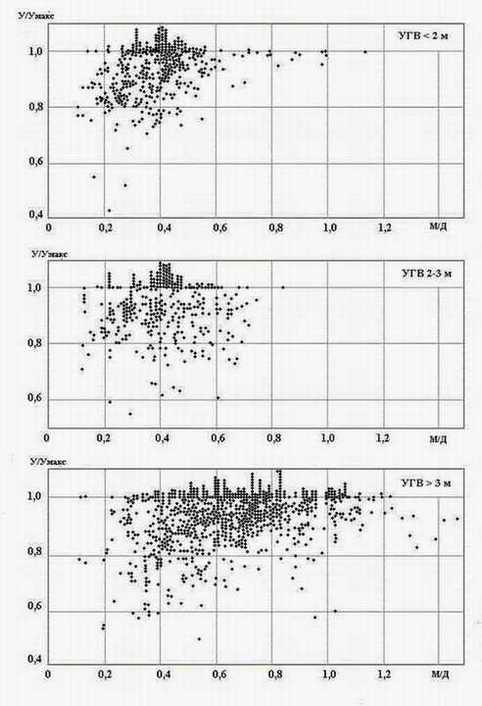Morozov
A.N.
Lecture 6. Total seasonal water requirement of
plants and specifics of development of their different phases.
| I am quite agreeable
with advice of I.I. Pavlov: "raise hat in front of Mr.Fact". But not
far from that would be an advice - put on hat and think twice on real value of
the fact. |
| I.V. DAVIDOWSKIY |
Possibly nobody will be against the fact that required
amount of irrigation directly depend on climate conditions…
Let us start
one after another, and begin from the question - how much water should be delivered
to a field and the delivery schedule to get implied yield. First of all, let us
have a look at Picture 2.1 where monthly average climatic characteristics of desert
zone of Uzbekistan present there. You can find the characteristics for your own
place in agro-climatic reference books at any time, and potential evaporation
from water surface can be calculated by using simple formula if you can not find
it in the same reference book).

Picture
2.1. Climatic characteristics and water balance deficit.
t - air temperature,
Centigrade degrees;
Ю - relative air humidity in %;
нЯ; - atmospheric
precipitations, mm.
еН- potential evaporation from water surface, Åî
= 0,00144 * (25 - t)2 * (100 - a) ;
еН = 0,00144 * (25 - t)2 * (100 - a) ;
- water balance deficit (colored with yellow for vegetation period).
Monthly
average air temperatures development, amount of precipitation, relative air humidity,
calculated evaporative rates and humidity deficits were shown on the picture.
Area of the figure colored with yellow - is deficits of vegetation period (IV…IX
months in this case). But each plant has its own date of seeding, vegetation period,
and that is why water requirements for irrigations will depend on these amounts
and stipulate its own irrigation period. I.e., short season varieties may require
significantly less water to complete its seasonable cycle than long season crops,
but it relates mainly not to perennial trees and bushes which require water during
all vegetation period.
Though water deficit - is not requirement itself
yet, but anyway, calculated monthly water deficits give us approximate values
in which months and how much evaporation exceeds precipitation, and that is good
few to understand if we need in irrigation or we can avoid it.
Scientists
found out that empiric equations which reflect relationships between moisture
deficit with actual water discharge by irrigated plants could be used for consumptive
water use calculation (if determine ratios that allow to find out relationship
between these indexes).
One of most simple relationship is like following:
лveg
= 10 * йЙ * д
лveg - irrigation water requirement for the considered
crop, m3/ha;
йЙ - empirical coefficient for the crop which depend on species
of plant and applied agro-technical measures and on vegetation period duration;
д - summary moisture deficit during vegetation period for the cultivated crop,
mm.
Phases of cotton development, starting date of vegetation, starting
date for irrigation period, share of physical evaporation (from soil surface)
for central climatic zone of Uzbekistan were shown as example at Picture 2.2.

Picture
2.2, Specific features (phases of development) for cotton in central climatic
zone of Uzbekistan.
To identify value of Êê ratio scientists
carry out long term experiments with various irrigation technologies and compare
achieved yields with water consumptions, then compare that with actual moisture
deficits. These works provide them (to scientists) lifetime employment because
plants varieties, applied agricultural methods, irrigation procedures and also
climate (it is not uniform as you know) change over the years… so, that can
be studied for a long time, even we can say for never-ending long time. At picture
2.3 we showed results of generalization of information on study for cotton irrigation
procedures approximately for 70 years. About 270 tests carried out at more than
13 experiment station of Uzbekistan were included there. This crop was most required
for a long time, and most of all investigations were carried out foe it, well,
about ten times more than the same for lucerne, wheat and corn!
Let us investigate
carefully three diagrams at Picture 2.3. We shall clarify a little about the core
of these diagrams. Here, с - is a yield at some plot in frames of this experience,
and сЛЮУ - is top yield at the plot, where best condition for water supply was
provided during this experience.
All the results compared along the plots
for each test, for each investigated year were obtained at the same weather conditions,
but value of relationship for irrigation rate to moisture deficit during vegetation
period (л/д) for each of the plot was different and the yield should depend only
on irrigation water volume. But as we can see from the pictures, yield close to
maximal one (с/сЛЮУ = 1) found in various tests when relationship between irrigation
rate and moisture deficit fo vegetation period are from 0,15 up to 1,2 i.e. there
is difference almost ten times! And we can not understand why it is so, because
we specially selected only that results where the same "history" was
and only irrigation rates were changed. And this spread of data is almost the
same both for close ground water table (GWT) and for deep GWT!
It is also
important to note that maximal yields at the selected for analyses trials were
not essentially lower than 45 .. 50 hundreds kilograms per hectare and mainly
the lowest yields were typical for north regions of Uzbekistan.
Possibly,
yield depends not only on the "history" and on volume of delivered irrigation
water, but does it also connected with skill of farmers? What do you think about
that? Anyway, this wealth of material is waiting for their researchers and assayers…
And we have no way than to orient to "golden mean" of tested "clouds"
of data and take the very same ratio by 2.1 formulas. йЙ = л/д = 0,4┘0,65 (smaller
values for close GWT, and larger meanings for deep GWT). Nevertheless, it is not
bad for orienting. Being aware of deficit for vegetation period from weather data,
we can multiply it to Êê factor, and obtain approximate requirement
for irrigation water. Total deficit for vegetation period (IV…IX months)
is about 1000 mm. Then, irrigation water requirement will be from 400 up to 650
mm, or in terms of m3/ha it will be 4000…6500 m3/ha. About the same amount
is necessary for grain maize, but it has declined by a third for grain crops,
i.e., 3000…4500 m3/ha. It is necessary to mention that a part of this requirement
could be covered by deposit of moisture during non-vegetation period, if it can
be saved in soil by correct agricultural methods

Picture 2.3. Actual data on amount of irrigation water used for cotton,
which was obtained from tests of different scientists. Data obtained at GWT close
to surface were collected on upper picture, data obtained at GWT between close
and deep - are on the medium picture, and GWT at lower than 3 m - are on the lowest
picture. (Points over с/сЛЮУ = 1 are conventional, they show only number of tests,
which were used for evaluation of various relationships between л/д and for graph
plotting).
So far we deal with average annual climate records, but all
years are different in nature, there are dry years, but there are also rainy years.
It is natural, that there is necessity to irrigate in rainy years, but it is necessary
to irrigate in dry years. That is why equipment for irrigation will be used only
in particular dry years. But sometimes, stability of cropping capacity from year
to year can be more important than some extra costs for management of irrigation.
Further on (in Chapter 9) we shall tell you a little about what for else
water is consumed at irrigation systems to maintain healthy growth of plants at
fields, and you won't find it funny!
Below in Table 3.1 values of Êê
for various crops in Uzbekistan were shown as example, that was taken from the
work where generalized great experience of scientists of Central Asia (Design
values of irrigation water requirements for crops in Syrdarya and Amudarya rivers
basins. Authors: V.R. Shreder, V.f. Safonov and others). I take off my hat as
a sign of great respect in the memory of great scientist - my edifier V.R. Shreder,
who was a guru of this giant work, I intentionally introduced you with the data,
which were used during its development, and that was done with the purpose - you
are to be doubtingly upon any conclusion that does not belong to you and not trust
to anybody's orally told conclusion.
Table 6.1. Values of йЙ factors for
various crops in accordance with climatic zones of Uzbekistan.
In accordance
with climatic zones
Crop | Ñ-1 |
Ñ-2 | Ö-1
| Ö-2 |
Þ-1 | Þ-2 |
Cotton |
- | 0,60 |
0,63 | 0,65 |
0,68 | 0,70 |
Lucerne and other green food. |
0,77 | 0,81 |
0,84 | 0,88 |
0,92 | 0,95 |
Gardens and other plants |
0,53 | 0,55 |
0,58 | 0,60 |
0,62 | 0,65 |
Vineyards |
0,44 | 0,46 |
0,48 | 0,50 |
0,52 | 0,54 |
Grain maize and sorgho |
0,62 | 0,61
| 0,62 |
0,59 | 0,58
| 0,57 |
Cultivated crops with double crops |
- | - |
0,66 | 0,69 |
0,72 | 0,75 |
Cucurbits crops |
0,35 | 0,34 |
0,33 | 0,33 |
0,33 | 0,32 |
Late cucurbits crops |
- | - |
0,31 | 0,31 |
0,31 | 0,30 |
Long term vegetables |
0,76 | 0,79 |
0,82 | 0,86 |
0,89 | 0,93 |
Rathe-ripes vegetables and potato with double
crops | 0,79 |
0,83 | 0,86 |
0,90 | 0,94 |
0,97 |
Late
vegetables and potato. | - |
- | 0,69 |
0,68 | 0,67
| 0,66 |
Average
values of moisture deficits during vegetation period according to climatic zones
of even lands of Uzbekistan were shown below in Table 6.2.
Table 6.2. Average
values of moisture deficits during vegetation period according to climatic zones
of even lands of Uzbekistan (mm).
|
я-1 | я-2 |
ж-1 | ж-2 |
ч-1 | ч-2 |
| 900 | 950 |
1000 | 1050 |
1100 | 1150 |
Further on we shall tell you a little about what for else water is
spent at irrigation systems to maintain health growth of the plated crops at fields,
and "there'll be hell to pay"!
Then we shall address you to experience
of the great of soil science and agricultural engineering and we shall think a
little together with you how water could be used more efficiently, either the
water that is obtained for irrigation, or the water that is abstracted from natural
water resources which could be saved by cheep and plain ways. But we shall tell
about that a little bit later, after you get more familiar with HER MAJESTRY,
FOSTERER OF ALL FLESH ON LAND - SOIL!

